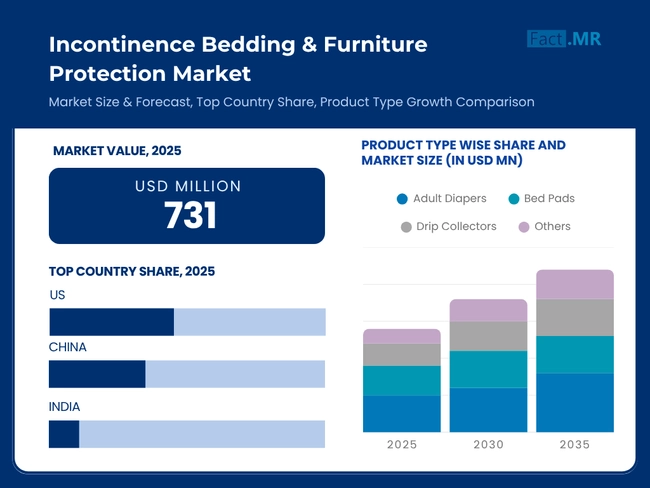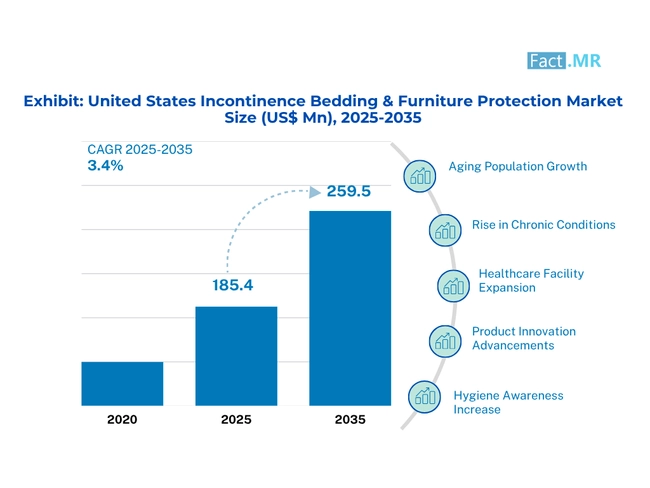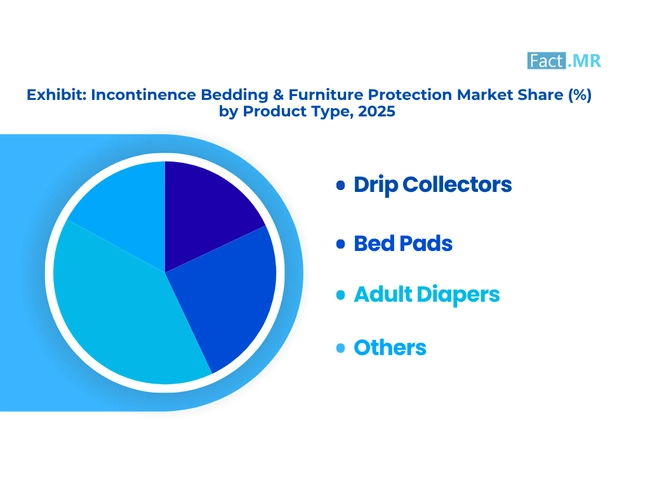Incontinence Bedding & Furniture Protection Market
Incontinence Bedding & Furniture Protection Market Analysis, By Product Type, By Usage (Reusable and Disposable), By Distribution Channel, and Region - Market Insights 2025 to 2035
Analysis of Incontinence Bedding & Furniture Protection Market Covering 30+ Countries Including Analysis of US, Canada, UK, Germany, France, Nordics, GCC countries, Japan, Korea and many more.
Incontinence Bedding & Furniture Protection Market Outlook (2025 to 2035)
The global incontinence bedding & furniture protection market is expected to reach USD 1,236 million by 2035, up from USD 696 million in 2024. During the forecast period 2025 to 2035, the industry is projected to register at a CAGR of 5.4%.
The increase in urinary incontinence instances among aging populations is driving the demand for protective bedding and furniture products. The rising sensitivity toward hygiene and comfort in both the homecare and healthcare sectors continues to be a key driver of industry growth.

What are the drivers of incontinence bedding & furniture protection market?
The increasing prevalence of urinary incontinence among the aging population drives the incontinence bedding and furniture protection market. The aging population in most parts of the world, as well as in countries such as Japan, Germany, and the USA, in particular, has increased the consumption of disposable and washable bed protectors, mattress overlays, and absorbent furniture pads. Such demographic change also comes with increased attention to patients regarding their comfort, hygiene, and the management of care at home.
The need to optimize healthcare costs has further compelled institutions and families to utilize reusable protective solutions. They are also driving the kind of product adoption achieved through innovation in materials, such as breathable materials that retain moisture, and in odor control technologies. Furthermore, awareness has been raised through advocacy campaigns, such as the one conducted by the Continence Foundation, which has waged a war against stigma and promoted the active use of products.
The transformation of eldercare homes and the increase in home rehabilitation processes following surgeries have also contributed to the market's growth. The growth of retail and e-commerce, which includes the discreet provision of delivery, promotes consumer accessibility and leads to increased sales.
What are the regional trends of incontinence bedding & furniture protection market?
North America dominates the regional market, driven by high healthcare expenditure, early adoption of elderly care technologies, and favorable reimbursement models.
Europe is not far behind, particularly in countries such as Germany and the UK, where aging incidences and government efforts to keep the citizens healthy have increased market penetration.
The Asia Pacific is becoming a high-demanding area, where healthcare infrastructure is growing and there is an increasing concern about the care of incontinence. The high-quality aging support environment of Japan and China's accumulating investment in homecare equipment have stimulated product uptake. The Southeast Asian region is experiencing slow but steady development through urbanization and the restructuring of its healthcare system.
In Latin America and the Middle East, the market has not matured yet, but is one that is getting larger as a result of issues related to medical tourism, growing networks of hospitals, and an aging population. The regional dynamics indicate an increasing tendency to adopt environmental friendliness, the reusability of protection options, and various public-private initiatives to incorporate eldercare products into national health plans.
What are the challenges and restraining factors of incontinence bedding & furniture protection market?
There are market challenges like the stigma attached to consumers of incontinence products. Underreporting and underuse are very common in developing nations due to cultural taboos and embarrassment. This mental block still impedes infiltration into the incontinence bedding & furniture protection market.
There is also the issue of pricing for the products, especially those that are reusable and high-tech in the bedding solutions; these have proven to be unaffordable for low-income groups. Adoption may also be limited due to reimbursement issues and regional healthcare coverage limitations. Then, there is a lack of awareness and inadequate distribution of products in rural and semi-urban areas, which worsens sales, particularly in Asia and Africa.
There is growing environmental interest in the disposal of disposable protective bedding, which is driving regulation and a demand for sustainability. Producers also encounter technical difficulties in balancing comfort, absorbency, endurance, and ecological impact. Finally, repeat washability is a barrier to washable products; the sustainability of product functionality following repeated washing affects consumer trust in the product and their likelihood of repeat buying.
Country-Wise Outlook
Ageing with dignity: Germany’s stronghold in incontinence bedding solutions
Germany, known for its higher rate of aging population leading to a rising prevalence of chronic conditions such as neurodegenerative diseases and mobility impairments. The percentage of its citizens aged 65 and older is above 22 percent, which means that the number of people in need of protective bedding in home care and long-term care facilities is increasing significantly.
The focus of the support policy on eldercare has increased reimbursement for assistive products in Germany. Absorbent underpads, waterproof bed covers, and furniture shields that can be washed and reused can be purchased through public and private insurance programs. Moisture sensors placed on smart beds and the digitization of care homes are on the rise. Manufacturers are coming up with novel materials in the form of breathable antimicrobial textiles to guard bedridden patients against pressure ulcers and skin irritations.
Tech-integrated care: USA drives innovation in incontinence furniture protection

The United States is also a leading industry because it has a high number of the aging population and the mobility-impaired. Here, the incontinence protection market is driven by customer demand, which is influenced by their preference for comfort, discretion, and hygiene across both healthcare environments and homes.
High-tech disposable bed pads, furnishing liners that control odor and reusable mattress covers that utilize multi-layer shields are the products that dominate the portfolios. Medicaid and Medicare insurance coverage support adoption in long-term care facilities. Innovative protection products, such as moisture-sensing alarm pads and AI-enhanced predictive care sites, are transforming product development. Hospitals and suppliers of assisted living centers are being compelled to adapt to changes in federal safety regulations by utilizing fabrics that are resistant to fire or antimicrobial.
Rising elderly dependency spurs demand in Japan’s hygiene furniture market
Japan is rapidly expanding its incontinence bedding and furniture protection systems in response to the needs and demands of its super-aged society, where approximately 29 percent of the population has reached 65 years or older. The Community-Based Integrated Care System in the government guarantees representation of elder-friendly facilities and homes with hygienic, ergonomic bedding aids.
Japanese manufacturers are also developing washable covers for beds made from ultra-light, ultra-fast-drying, and anti-leak materials. Combining robotic caregiving devices (e.g., bed-moving robots with moisture sensors) and the Internet of Things-based elder monitoring systems is becoming the norm. The health promotion campaigns and subsidies for caregiving provided by the government under the Japanese Long-Term Care Insurance (LTCI) program enabled the mass production of protective furniture equipment, particularly in rural clinics and urban geriatric departments.
Category-Wise Analysis
Drip collectors gain traction as a crucial product in managing incontinence in institutional settings
Drip collectors can be used as a first-line defense in controlling furniture soiling during incontinence care, as they provide hygienic containment against minor urine leaks, particularly in medical and aged care facilities. They are invaluable in institutional facilities such as hospitals, nursing homes, and long-term care facilities due to their ability to both reduce cleanup risks and minimize the risk of infection. They are versatile in terms of bedding and sitting positions, making them more multipurpose in various care points.

Reusable solutions lead the sustainability shift in incontinence protection
The product classification indicates a significant shift in focus towards reusable incontinence products, driven by both monetary and environmental considerations. The reusable drip collectors are economical in the long run, with less waste and even the repeated buying of goods, which is common in big volume institutions. The innovations in absorbent textiles and waterproof barrier layers, however, have increased the efficacy of reusable products to match those of disposable products, meeting the institution's sustainability requirements and the concept of the circular economy.
Institutional sales channel dominates as healthcare providers demand scalable incontinence solutions
Their primary point of distribution is institutional sales, driven by the lead of healthcare institutions and eldercare homes in demand generation. Stable and recurring sales volumes result from large-scale purchases made by hospitals, assisted living centers, and rehabilitation facilities. Regulatory compliance, hygiene standards, and product consistency characterize these channels as long-term-oriented contractors, and institutional sales are a central point in the incontinence bedding & furniture protection market revenue.
Competitive Analysis
The incontinence bedding and furniture protection market is experiencing a period of consistent growth, attributed to the increasing age of the global population and a growing interest in improving the lives of individuals with incontinence.
With increasing awareness and openness about incontinence, the specifications for discreet, comfortable, and simple-to-use protective solutions are also increasing among caregivers and users. This transition is seeing advancements in product design, especially improvements in absorbency, breathable materials, and odor control technologies that emphasize comfort and dignity.
Home-based care is also influencing the market, resulting in demand for flexible protection products that fit into a wide range of environments, from home beds to upholstered furniture. Sustainability is becoming a key factor, and there is a slow trend toward switching to reusable and environmentally friendly product alternatives that minimize negative effects.
Through e-commerce and the multiplication of distribution channels, customers have gained greater access to products, resulting from this diversification in the market. In the meantime, there is a race between manufacturers as they invest in user-friendly features and more fashionable, less clinical designs that fit into the domestic environment. The market also continues to struggle with balancing affordable innovation against sustainability, despite the positive momentum it has gained. The competitive benefits will be huge for the company, which will be able to provide cost and performance expectations.
Key players in the incontinence bedding & furniture protection industry are Ontex, Essity, ConvaTec Inc., Coloplast Corp, Procter & Gamble, Kimberly-Clark Corporation, PAUL HARTMANN AG, Domtar Corporation, Wellspect HealthCare, Hollister Incorporated, and other players.
Recent Development
- In June 2024, Welspun Living, a leading Indian textile company, expanded its advanced textiles division to include high-performance, non-woven products for personal protection. This move aims to cater to the growing demand for quality Incontinence Bedding & Furniture Protection solutions in both domestic and international markets.
- In May 2023, Grace launched its plant-based incontinence product line across 1,600 Walmart Supercenters and online platforms. The products feature 100% plant-based topsheets and backsheets, offering a sustainable and skin-friendly alternative for women managing urinary incontinence. This expansion aims to enhance accessibility and promote eco-conscious personal care.
Fact.MR has provided detailed information about the price points of key manufacturers in the incontinence bedding & furniture protection market, positioned across regions, including sales growth, production capacity, and speculative technological expansion, in the recently published report.
Methodology and Industry Tracking Approach
In conducting global research on the incontinence bedding and furniture protection market in 2025, Fact.MR engaged 6,400 participants across 26 countries, with each market having at least 200 respondents. Almost 70 percent of the respondents were end-users and suppliers (nursing homes and homecare providers to manufacturers of protective medical textiles). The rest (30%) constituted procurement managers, healthcare infrastructure planners and hygiene consultants with their focus on eldercare.
The study's ideas were informed by a 1-year evaluation period, beginning in June 2024 and concluding in May 2025, with a focus on the needs of changing products, capital investments, risks in supply and distribution procurement, and gaps in the value chains of institutional and at-home care.
To achieve analytical rigor, the study drew on more than 180 external sources, including healthcare journals, patent publications, industry codes of compliance, and corporate financial reports. Further precision has been achieved through cluster segmentation mapping and modeling of predictive regression, which provided a solid insight into future demand curves.
Beginning 2018 Fact.MR followed up on user behavioral changes, advances in hygiene care, and a global shift in supply chains, making this 2025 report an apt benchmark reference source for stakeholders in the incontinence bedding and furniture protection value chain.
Segmentation of Incontinence Bedding & Furniture Protection Market
-
By Product Type :
- Drip Collectors
- Pessaries
- Adult Diapers
- Cunningham Clamps
- Bed Pads
- Bed Sheets
-
By Usage :
- Reusable
- Disposable
-
By Distribution Channel :
- Institutional Sales
- Retail Stores
- Online Channels
-
By Region :
- North America
- Latin America
- Western Europe
- Eastern Europe
- East Asia
- South Asia & Pacific
- Middle East & Africa
Table of Content
- Executive Summary
- Industry Introduction, including Taxonomy and Market Definition
- Trends and Success Factors, including Macro-economic Factors, Market Dynamics, and Recent Industry Developments
- Global Market Demand Analysis 2020 to 2024 and Forecast 2025 to 2035, including Historical Analysis and Future Projections
- Global Market Analysis 2020 to 2024 and Forecast 2025 to 2035
- Product Type
- Usage
- Distribution Channel
- Global Market Analysis 2020 to 2024 and Forecast 2025 to 2035, By Product Type
- Drip Collectors
- Pessaries
- Adult Diapers
- Cunningham Clamps
- Bed Pads
- Bed Sheets
- Global Market Analysis 2020 to 2024 and Forecast 2025 to 2035, By Usage
- Reusable
- Disposable
- Global Market Analysis 2020 to 2024 and Forecast 2025 to 2035, By Distribution Channel
- Institutional Sales
- Retail Stores
- Online Channels
- Global Market Analysis 2020 to 2024 and Forecast 2025 to 2035, By Region
- North America
- Latin America
- Western Europe
- South Asia & Pacific
- East Asia
- Eastern Europe
- Middle East & Africa
- North America Sales Analysis 2020 to 2024 and Forecast 2025 to 2035, by Key Segments and Countries
- Latin America Sales Analysis 2020 to 2024 and Forecast 2025 to 2035, by Key Segments and Countries
- Western Europe Sales Analysis 2020 to 2024 and Forecast 2025 to 2035, by Key Segments and Countries
- South Asia & Pacific Sales Analysis 2020 to 2024 and Forecast 2025 to 2035, by Key Segments and Countries
- East Asia Sales Analysis 2020 to 2024 and Forecast 2025 to 2035, by Key Segments and Countries
- Eastern Europe Sales Analysis 2020 to 2024 and Forecast 2025 to 2035, by Key Segments and Countries
- Middle East & Africa Sales Analysis 2020 to 2024 and Forecast 2025 to 2035, by Key Segments and Countries
- Sales Forecast to 2035 by Product Type, Usage, and Distribution Channel for 30 Countries
- Competitive Assessment, Company Share Analysis by Key Players, and Competition Dashboard
- Company Profile
- Ontex
- Essity
- ConvaTec Inc.
- Coloplast Corp
- Procter & Gamble
- Kimberly-Clark Corporation
- PAUL HARTMANN AG
- Domtar Corporation
- Wellspect HealthCare
- Hollister Incorporated
- FAQs -
What was the global incontinence bedding & furniture protection market size reported by Fact.MR for 2025?
The Global Incontinence Bedding & Furniture Protection Market was valued at USD 731 Million in 2025.
Who are the major players operating in the incontinence bedding & furniture protection market?
Prominent players in the market Ontex, Essity, ConvaTec Inc., Coloplast Corp, Procter & Gamble, Kimberly-Clark Corporation, PAUL HARTMANN AG, Domtar Corporation, Wellspect HealthCare, and Hollister Incorporated.
What is the estimated valuation of the incontinence bedding & furniture protection market in 2035?
The market is expected to reach a valuation of USD 1,236 Million in 2035.
What Value CAGR did the incontinence bedding & furniture protection market exhibit over the last five years?
The historic growth rate of the Incontinence Bedding & Furniture Protection Market was 4.7% from 2020 to 2024.